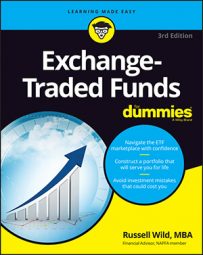Corporate bonds typically pay higher rates than government bonds (about 1 percent a year higher), so you would expect the long-term payout from this ETF to be higher than any government bond ETF, except perhaps for the longest of the long-term government bond ETFs.
In the area of corporate bonds, credit ratings are essential. Know that the average bond rating of the iShares iBoxx $ Investment Grade Corporate Bond Fund is A, which means, more or less, that the bonds are issued by companies that are fairly solvent (although certainly not on a par with the U.S. government).
iBoxx $ Investment Grade Corporate Bond Fund (LQD)
Indexed to: The iBoxx $ Liquid Investment Grade Index — an index of bond issues sponsored by a chorus line of companies rated “investment grade” (which means highly unlikely to go bankrupt any time soon) or above. Technically, we’re speaking of bonds rated BBB or better by S&P. About 600 bonds are typically used to create a representative sampling of this universe.
Expense ratio: 0.15 percent
Current yield: 3.99 percent
Average credit quality: A
Average weighted maturity: 11.8 years
Investment-grade corporate bonds have done a pretty good job of holding their own in bad times. You get a bit more return than you do with Treasurys of equal maturity, although unlike Treasurys, with corporate bonds you pay state taxes on the dividends. If your portfolio is large enough, you want LQD, as well as one of the conventional Treasury and inflation-adjusted Treasury ETFs.
Vanguard Short-Term Corporate Bond Index (VCSH)
Indexed to: The Barclays U.S. 1–5 Year Corporate Index, a pot of about 1,400 bonds from corporations that the raters think have little chance of going belly up
Expense ratio: 0.15 percent
Current yield: 1.76 percent
Average credit quality: A
Average weighted maturity: 3.0 years
In normal times, financial planners encourage most investors to stick with intermediate-term bonds and forget about short-term bonds that typically yield considerably less. However, when interest rates are as low as they have been in decades, they tend to lean more to the short-term.
Reason: When interest rates rise, as eventually they will, longer-term bonds are going to get hit. For more conservative investors especially, VCSH, during times of very low interest rates, may warrant half your allocation to corporate bonds. When interest rates start to climb back up to more normal historical levels, you may then want to move some or all of the money in VCSH to LQD.

